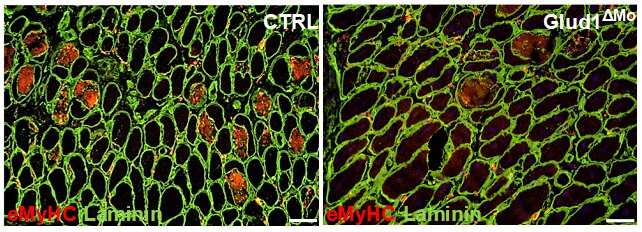A team in Belgium led by Prof. Massimiliano Mazzone (VIB-KU Leuven Center for Cancer Biology), in collaboration with the Dr. Emanuele Berardi and Dr. Min Shang, Has published in Nature a revolutionary study.
In summary: There is a metabolic relationship between inflammatory cells and muscle stem cells. The researchers showed that if this metabolic "dialogue" is strengthened with an inhibitor of the GLUD1 enzyme, the release of glutamine, an amino acid, occurs. which could play an incredible role in muscle regeneration.
Glutamine improves muscle regeneration and physical performance in experimental models of muscle degeneration such as trauma, ischemia and aging.
This study promises important advances in several research fields, including muscle biology, immunometabolism and stem cell biology.

The role of glutamine
Skeletal muscle, as it is known, is essential for moving our body. That's not his only property, though. It is also a large reservoir of amino acids stored as proteins, and is capable of influencing energy and protein metabolism throughout the human body.
The role of the amino acid glutamine has always been considered central to muscle metabolism, given its abundance in our body.
However, its precise role after trauma or in the course of chronic muscular degenerative conditions has been largely overlooked.
The team of the Prof. Massimiliano Mazzone observed that, with damage or during aging, normal glutamine levels in muscles drop as a result of muscle tissue death.
Researchers have identified a metabolic dialogue that is established between the inflammatory cells arriving after injury and the resident muscle stem cells. This cellular "partnership" restores the original levels of glutamine in the muscle and, in doing so, stimulates the regeneration of muscle fibers.
Muscle regeneration
Using cutting-edge in vitro and in vivo methodologies, researchers have demonstrated that muscle injury, ischemia and age-related muscle atrophy are conditions characterized by a reduced glutamine.
Dr. Berardi explains: “By using genetic and pharmacological tools that inhibit GLUD1, an enzyme that metabolizes glutamine, we were able to prevent the post-injury decline in this enzyme. This led to the overproduction of glutamine by inflammatory cells, called macrophages, which reach the damaged muscle.
Newly produced glutamine could be used by muscle stem cells to rapidly regenerate damaged muscle tissue. We have found the same thing in acute and chronic degenerative conditions, such as aging, leading to faster muscle functional recovery.”
Prevent degeneration
This study reveals that glutamine is a sensor molecule whose levels in muscle tissue control a regenerative program.
Second: the GLUD1 enzyme could allow regeneration opportunities for muscles damaged by degenerative conditions or aging.
Prof. Mazzone underlines the potential of the discovery: “We have hope for the treatment of degenerative muscle conditions including trauma, ischemia, aging and even muscular dystrophy.”


